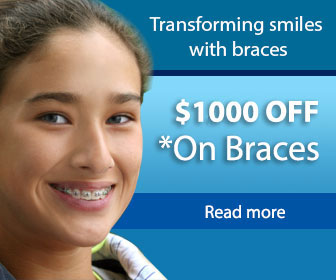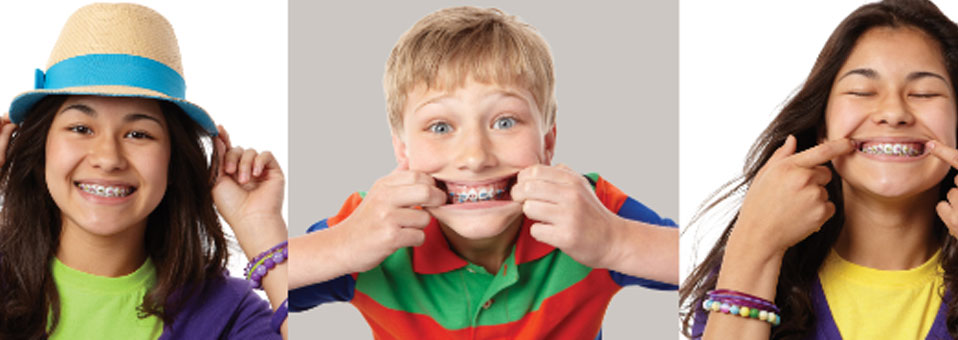

Orthodontics is the branch of dentistry that specializes in the diagnosis, prevention and treatment of dental and facial irregularities. The technical term for these problems is “malocclusion,” which is Latin for “bad bite.” The practice of orthodontics requires professional skill in the design, application and control of corrective appliances, such as braces, to bring teeth, lips and jaws into proper alignment and to achieve facial balance.
All orthodontists are dentists, but only about 5 percent of dentists are orthodontists. An orthodontist is a specialist in the diagnosis, prevention and treatment of dental and facial irregularities. Orthodontists must first attend college, and then complete a three to five year dental graduate program at an accredited dental school. They must then successfully complete an additional two- to three-year ADA-accredited residency program of advanced education in orthodontics. The entrance into an orthodontic residency is highly competitive and most orthodontists graduate in the top 5-10% of their dental class. Through this training, the orthodontist learns the skills required to manage tooth movement (orthodontics) and guide facial development (dentofacial orthopedics).
Only dentists who have successfully completed this advanced specialty education may call themselves orthodontists.The American Association of Orthodontists is the national organization of dental specialists who limit their practice to orthodontics and dentofacial orthopedics. Founded in 1900, the AAO is the oldest and largest dental specialty organization in the world. To date, the AAO has more than 14,600 members, including more than 2,000 international members from outside North America. This membership consists of approximately 94 percent of all orthodontists who currently practice in the United States. Only orthodontists may be members of the AAO.
The AAO is dedicated to advancing the art and science of orthodontics and dentofacial orthopedics, improving the health of the public by promoting quality orthodontic care, and supporting the successful practice of orthodontics. All members must meet the specialty educational requirements as defined by the Commission on Dental Education of the American Dental Association.
The American Dental Association has recognized that “specialists are necessary to protect the public, nurture the art and science of dentistry, and improve the quality of care.”
Children and adults can both benefit from orthodontics, because healthy teeth can be moved at almost any age. Because monitoring growth and development is crucial to managing some orthodontic problems well, the American Association of Orthodontists recommends that all children have a check-up with an orthodontic specialist no later than age seven. Some orthodontic problems may be easier to correct if treated early. Waiting until all the permanent teeth have come in, or until facial growth is nearly complete, may make correction of some problems more difficult.
An orthodontic evaluation at any age is advisable if a parent, family dentist or the patient's physician has noted a problem.
Most malocclusions are inherited, but some are acquired. Inherited problems include crowding of teeth, too much space between teeth, extra or missing teeth, and a wide variety of other irregularities of the jaws, teeth and face.
Acquired malocclusions can be caused by trauma (accidents), thumb, finger or pacifier sucking, airway obstruction by tonsils and adenoids, dental disease or premature loss of primary (baby) or permanent teeth. Whether inherited or acquired, many of these problems affect not only alignment of the teeth but also facial development and appearance as well.
Crowding: Teeth may be aligned poorly because the dental arch is small and/or the teeth are large. The bone and gums over the roots of extremely crowded teeth may become thin and recede as a result of severe crowding. Impacted teeth (teeth that should have come in, but have not), poor biting relationships and undesirable appearance may all result from crowding.
Overjet or protruding upper teeth: Upper front teeth that protrude beyond normal contact with the lower front teeth are prone to injury, often indicate a poor bite of the back teeth (molars), and may indicate an unevenness in jaw growth. Commonly, protruded upper teeth are associated with a lower jaw that is short in proportion to the upper jaw. Thumb and finger sucking habits can also cause a protrusion of the upper incisor teeth.
Deep overbite: A deep overbite or deep bite occurs when the lower incisor (front) teeth bite too close or into the gum tissue behind the upper teeth. When the lower front teeth bite into the palate or gum tissue behind the upper front teeth, significant bone damage and discomfort can occur. A deep bite can also contribute to excessive wear of the incisor teeth.
Open bite: An open bite results when the upper and lower incisor teeth do not touch when biting down. This open space between the upper and lower front teeth causes all the chewing pressure to be placed on the back teeth. This excessive biting pressure and rubbing together of the back teeth makes chewing less efficient and may contribute to significant tooth wear.
Spacing: If teeth are missing or small, or the dental arch is very wide, space between the teeth can occur. The most common complaint from those with excessive space is poor appearance.
Crossbite: The most common type of a crossbite is when the upper teeth bite inside the lower teeth (toward the tongue). Crossbites of both back teeth and front teeth are commonly corrected early due to biting and chewing difficulties.
Underbite or lower jaw protrusion: About 3 to 5 percent of the population has a lower jaw that is to some degree longer than the upper jaw. This can cause the lower front teeth to protrude ahead of the upper front teeth creating a crossbite. Careful monitoring of jaw growth and tooth development is indicated for these patients
Crooked and crowded teeth are hard to clean and maintain. This may contribute to conditions that cause not only tooth decay, but also eventual gum disease and tooth loss. Other orthodontic problems can contribute to abnormal wear of tooth surfaces, inefficient chewing function, excessive stress on gum tissue and the bone that supports the teeth, or misalignment of the jaw joints, which can result in chronic headaches or pain in the face or neck.
When left untreated, many orthodontic problems become worse. Treatment by a specialist to correct the original problem is often less costly than the additional dental care required to treat more serious problems that can develop in later years.
The value of an attractive smile should not be underestimated. A pleasing appearance is a vital asset to one’s self-confidence. A person's self-esteem often improves as treatment brings teeth, lips and face into proportion. In this way, orthodontic treatment can benefit social and career success, as well as improve one's general attitude toward life.
Review the recommended treatment with your family dentist. If you would still like to compare your comfort level with another orthodontic office or simply hear another orthodontist's assessment of your child's problem, arrange for a second opinion. You may have already had more than one orthodontist recommended to you by family, friends, your dentist or the AAO's locator service. Seeking out a member of the AAO assures that your second opinion is from an educationally qualified orthodontic specialist. You should feel confident in the orthodontist and his or her staff, and trust their ability to provide you the care and lifetime orthodontic value you seek.
The actual cost of treatment depends on several factors, including the severity of the patient's problem and the treatment approach selected. You will be able to thoroughly discuss fees and payment options before any treatment begins. Most orthodontists offer convenient payment plans to patients. Arrangements we offer often include an initial down payment with monthly installments, credit card payment, and other innovative ways to make treatment affordable. Insurance plans or other employer-sponsored payment programs, such as direct reimbursement plans, may be helpful.
In general, active treatment time with orthodontic appliances (braces) ranges from one to three years. Interceptive, or early treatment procedures, may take only a few months. The actual time depends on the growth of the patient's mouth and face, the cooperation of the patient and the severity of the problem. Mild problems usually require less time, and some individuals respond faster to treatment than others. Use of rubber bands and/or headgear, if prescribed by the orthodontist, contributes to completing treatment as scheduled.
While orthodontic treatment requires a time commitment, patients are rewarded with healthy teeth, proper jaw alignment and a beautiful smile. Teeth and jaws in proper alignment look better, work better, contribute to general physical health and can improve self-confidence.
Diagnostic records are made to document the patient's orthodontic problem and to help determine the best course of treatment. As orthodontic treatment will create many changes, these records are also helpful in determining progress of treatment. Our complete diagnostic records typically include a medical/dental history, clinical examination, a digital scan for study models of your teeth, photos of the patient's face and teeth, a panoramic or other X-rays of all the teeth, a facial profile X-ray, and other appropriate X-rays. This information is used to plan the best course of treatment, help explain the problem, and propose treatment to the patient and/or parents.
The profile X-ray, or cephalometric film, shows the facial form, growth pattern, and inclination of the front teeth (if teeth are tipped or tilted), which are essential in planning comprehensive treatment. Panoramic or other dental X-rays are used to locate impacted teeth, missing teeth, and shortened or damaged tooth roots, to determine the amount of bone supporting teeth, and to evaluate position and development of permanent teeth that have not yet come in, among other things. From the necessary records, a custom treatment plan is created for each patient.
At Blue Sky Orthodontics your safety and well-being is very important to us. X-rays do contain a small radiation dose to the patient. We keep this dose as low as reasonably possible and only take X-rays when they are necessary to providing a great orthodontic outcome.
That being said, here's the good news about the X-rays we take. The X-rays (panoramic and cephalometric) we take on most patients at the beginning of treatment equals the same background radiation you would get by just living on earth for two days. A cross country flight from New York to L.A. has about 10 days’ worth of background radiation. We normally take another set of X-rays at the end of treatment, so your total radiation dose is less than you would get by hopping on a plane!
Custom-made appliances, or braces, are prescribed and designed by the orthodontist according to the problem being treated. They may be removable or fixed (cemented and/or bonded to the teeth). They may be made of metal, ceramic or plastic. By placing a constant, gentle force in a carefully controlled direction, braces can slowly move teeth through their supporting bone to a new desirable position.
Orthopedic appliances, such as headgear, bionator, Herbst and maxillary expansion appliances, use carefully directed forces to guide the growth and development of jaws in children and/or teenagers. For example, an upper jaw expansion appliance can dramatically widen a narrow upper jaw in a matter of months. Over the course of orthodontic treatment, a headgear or Herbst appliance can dramatically reduce the protrusion of upper incisor teeth (the top four front teeth) or retrusion of the lower jaw (a lower jaw that is too far behind the upper jaw), while making upper and lower jaw lengths more compatible.
Today’s braces are generally less noticeable than those of the past when a metal band with a bracket (the part of the braces that hold the wire) was placed around each tooth. Now the front teeth typically have only the bracket bonded directly to the tooth. Brackets can be metal or clear depending on the patient’s preference. In some cases, brackets may be bonded behind the teeth (lingual braces). Many patients also have the option of Invisalign which is a set of removable, clear retainers that gradual move your teeth with each new tray.
In recent years, many advances in orthodontic materials have taken place. Braces are smaller and more efficient. The wires now being used are no longer just stainless steel. They are made of alloys of nickel, titanium, copper and cobalt, and some of the wires are heat-activated. (The nickel-titanium alloy was originally engineered by NASA to automatically activate antennae or solar panels of spacecraft orbiting into the sun’s rays.) These new kinds of wires cause the teeth to continue to move during certain phases of treatment, which may reduce the number of appointments needed to make adjustments to the wires.
Most people have some discomfort after their braces are first put on or when adjusted during treatment. After the braces are on, teeth may become sore and may be tender to biting pressures for three to five days. Patients can usually manage this discomfort well with whatever pain medication they might commonly take for a headache. The orthodontist will advise patients and/or their parents what, if any, pain relievers to take. The lips, cheeks and tongue may also become irritated for one to two weeks as they toughen and become accustomed to the surface of the braces. Overall, orthodontic discomfort is short-lived and easily managed.
Patients with braces must be careful to avoid hard and sticky foods. They must not chew on pens, pencils or fingernails because chewing on hard things can damage the braces. Damaged braces will almost always cause treatment to take longer, and will require extra trips to the orthodontist’s office.
Keeping the teeth and braces clean requires more precision and time, and must be done every day if the teeth and gums are to be healthy during and after orthodontic treatment. Patients who do not keep their teeth clean may require more frequent visits to the dentist for a professional cleaning.
The orthodontist and staff will teach patients how to best care for their teeth, gums and braces during treatment. The orthodontist will tell patients (and/or their parents) how often to brush, how often to floss, and, if necessary, suggest other cleaning aids that might help the patient maintain good dental health.
Successful orthodontic treatment is a “two-way street” that requires a consistent, cooperative effort by both the orthodontist and patient. To successfully complete the treatment plan, the patient must carefully clean his or her teeth, wear rubber bands, headgear or other appliances as prescibed by the orthodontist, and keep appointments as scheduled. Damaged appliances can lengthen the treatment time and may undesirably affect the outcome of treatment. The teeth and jaws can only move toward their desired positions if the patient consistently wears the forces to the teeth, such as rubber bands, as prescribed. Patients who do their part consistently make themselves look good and their orthodontist look smart.
To keep teeth and gums healthy, regular visits to the family dentist must continue during orthodontic treatment. Adults who have a history of or concerns about periodontal (gum) disease might also see a periodontist (specialist in treating diseases of the gums and bone) on a regular basis throughout orthodontic treatment.
Absolutely. And it's really simple. For the first few months after orthodontic treatment you will wear them for most of the day. After that, most people just need to wear them at night. Whether you have had ortho treatment or not, teeth are continually shifting throughout a person's life. When braces are finished the 'ligaments' between teeth want to pull them back to their original position. Retainers are a simple, effective way to keep your teeth straight and healthy for your entire life.
Ultimately, wearing retainers will be up to you. If straight teeth are no longer healthy and fashionable in 2023 , then you can stop wearing them. But if you want to keep your great smile until you are 120 years old (medical advances- you'll get there), wearing your retainers are a simple, effective way to Bring Your Smile.


Your dentist will know what appliance is best for your particular problem, but you often have a c ....

Patients with orthodontic problems can benefit from treatment at nearly any age. An ideal time fo ....